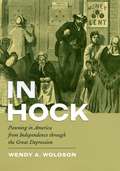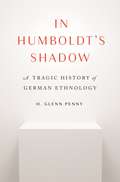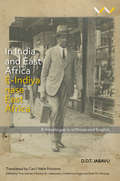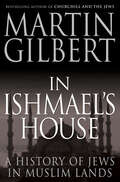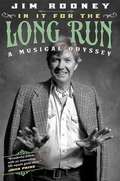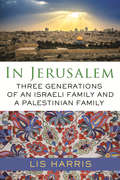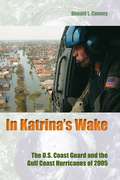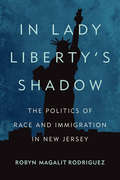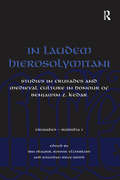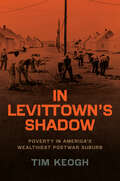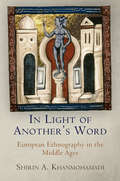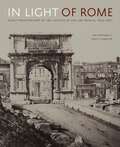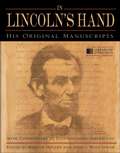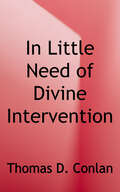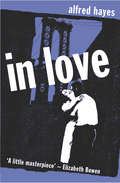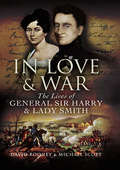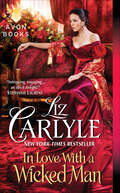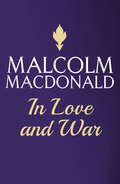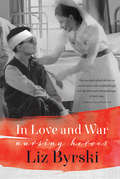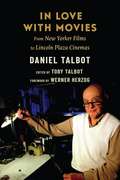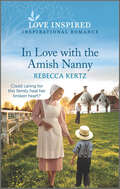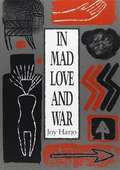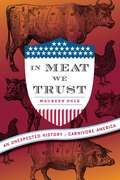- Table View
- List View
In Hock: Pawning in America from Independence through the Great Depression
by Wendy A. WolosonThe class of working poor begotten by this economic tide could make ends meet, Wendy Woloson argues, only by regularly visiting pawnshops to supplement their inadequate wages. Nonetheless, businessmen, reformers, and cultural critics berated the shops for promoting vice and used anti-Semitic stereotypes to cast their proprietors as greedy and cold-hearted. Parsing and subverting these caricatures, Woloson shows that pawnbrokers were in fact shrewd businessmen, often from humble origins, who honed sophisticated knowledge of a wide range of goods and their values in different markets. In the process, she paints a resonant portrait of the generations of Americans whose struggle for economic survival often depended on an institution that has remained, until now, woefully misunderstood.
In Hock: Pawning in America from Independence through the Great Depression
by Wendy A. WolosonThe definitive history of pawnbroking in the United States from the nation’s founding through the Great Depression, In Hock demonstrates that the pawnshop was essential to the rise of capitalism. The class of working poor created by this economic tide could make ends meet only, Wendy Woloson argues, by regularly pawning household objects to supplement inadequate wages. Nonetheless, businessmen, reformers, and cultural critics claimed that pawnshops promoted vice, and employed anti-Semitic stereotypes to cast their proprietors as greedy and cold-hearted. Using personal correspondence, business records, and other rich archival sources to uncover the truth behind the rhetoric, Woloson brings to life a diverse cast of characters and shows that pawnbrokers were in fact shrewd businessmen, often from humble origins, who possessed sophisticated knowledge of a wide range of goods in various resale markets. A much-needed new look at a misunderstood institution, In Hock is both a first-rate academic study of a largely ignored facet of the capitalist economy and a resonant portrait of the economic struggles of generations of Americans.
In Humboldt's Shadow: A Tragic History of German Ethnology
by H. Glenn PennyA compelling history of the German ethnologists who were inspired by Prussian polymath and explorer Alexander von HumboldtThe Berlin Ethnological Museum is one of the world's largest and most important anthropological museums, housing more than a half million objects collected from around the globe. In Humboldt's Shadow tells the story of the German scientists and adventurers who, inspired by Alexander von Humboldt's inclusive vision of the world, traveled the earth in pursuit of a total history of humanity. It also details the fate of their museum, which they hoped would be a scientists' workshop, a place where a unitary history of humanity might emerge.H. Glenn Penny shows how these early German ethnologists assembled vast ethnographic collections to facilitate their study of the multiplicity of humanity, not to confirm emerging racist theories of human difference. He traces how Adolf Bastian filled the Berlin museum in an effort to preserve the records of human diversity, yet how he and his supporters were swept up by the imperialist currents of the day and struck a series of Faustian bargains to ensure the growth of their collections. Penny describes how influential administrators such as Wilhelm von Bode demanded that the museum be transformed into a hall for public displays, and how Humboldt's inspiring ideals were ultimately betrayed by politics and personal ambition.In Humboldt's Shadow calls on museums to embrace anew Bastian's vision while deepening their engagement with indigenous peoples concerning the provenance and stewardship of these collections.
In India and East Africa E-Indiya nase East Africa: A travelogue in isiXhosa and English
by Tina Steiner Davidson Don Jabavu Mhlobo Jadezweni Catherine Higgs Evan M. MwangiA politician's journey to bring home Mahatma Gandhi's teachings home to South Africa in the wake of WWIIIn November 1949, Davidson Don Tengo (D.D.T.) Jabavu, the South African politician, Methodist lay preacher and retired professor of African languages and Latin at Fort Hare University in the Eastern Cape, set out on a four-month trip to attend the World Pacifist Meeting in India. The conference brought together delegates from over thirty countries to reflect on how Mahatma Gandhi’s life and teachings could inform pacifist work in the post-World War II era. Jabavu wrote an isiXhosa account of his journey up the east coast of Africa and to different parts of India which was first published in 1951 by Lovedale Press. His narrative contains wide-ranging reflections on the fauna and flora of the changing landscape, on intriguing social interactions during his travels, and on the conference itself, where he considered what lessons Gandhian principles might yield for oppressed South Africans engaged in struggles for freedom and dignity. He incorporates accounts of chance meetings with important figures of post-independence India and of the anti-colonial struggle in East Africa, as well as with members of the American civil rights movement. His commentary on non-violent resistance, and on the dangers of nationalism when coupled with militarism and racism, enriches the existing archive of intellectual and political exchange between Africa and India from a black South African perspective. This new edition includes Jabavu’s travelogue in the original isiXhosa, with an English translation by the late anthropologist Cecil Wele Manona. Tina Steiner’s introductory chapter examines the networks of international solidarity and friendship that Jabavu helped to strengthen in the course of his travels. A chapter by Mhlobo W. Jadezweni, whose updating of the original isiXhosa orthography has made Jabavu’s text accessible to new generations of readers, considers the richness of Jabavu’s isiXhosa style as a contribution to the archive of great African-language literature. Catherine Higgs provides biographical sketches of D.D.T. Jabavu and Cecil Wele Manona which situate this travelogue within the broader context of their lives. Evan M. Mwangi’s Afterword is a reflection on the historical and political significance of making African-language texts available to readers across Africa.
In Ishmael's House: A History of Jews in Muslim Lands
by Martin Gilbert&“In this epic examination, [a] celebrated historian explores the evolution of Judaism and Islam through a lens of Middle Eastern stability.&” (Publishers Weekly) The relationship between Jews and Muslims has been a flashpoint that affects stability in the Middle East with global consequences. In this eloquent book, Martin Gilbert presents a fascinating account of the hope and fear that have characterized these two peoples through the 1,400 years of their intertwined history. Harking back to the Biblical story of Ishmael and Isaac, Gilbert takes the reader from the origins of the fraught relationship—the refusal of Medina&’s Jews to accept Mohammed as a prophet—through the ages of the Crusader reconquest of the Holy Land and the great Muslim sultanates to the present day. He explores the impact of Zionism in the early twentieth century, the clash of nationalisms during the Second World War, the mass expulsions and exodus of 800,000 Jews from Muslim lands following the birth of Israel, the Six-Day War, and the political sensitivities of the current Middle East. Ishmael&’s House sheds light on a time of prosperity and opportunity for Jews in Muslim lands stretching from Morocco to Afghanistan, with many instances of Muslim openness, support, and courage. Drawing on Jewish, Christian, and Muslim sources, Gilbert uses archived material, poems, letters, memoirs, and personal testimony to uncover the human voice of this centuries-old conflict. Ultimately Gilbert&’s moving account of mutual tolerance between Muslims and Jews provides a perspective on current events and a template for the future. &“A reliable source and a pleasure to read.&” —Herman Wouk, Pulitzer prize winning author of The Caine Mutiny &“Moving and important.&” —The Independent
In It for the Long Run: A Musical Odyssey (Music in American Life)
by Jim RooneyInspired by the Hank Williams and Leadbelly recordings he heard as a teenager growing up outside of Boston, Jim Rooney began a musical journey that intersected with some of the biggest names in American music including Bob Dylan, James Taylor, Bill Monroe, Muddy Waters, and Alison Krauss. In It for the Long Run: A Musical Odyssey is Rooney's kaleidoscopic first-hand account of more than five decades of success as a performer, concert promoter, songwriter, music publisher, engineer, and record producer. As witness to and participant in over a half century of music history, Rooney provides a sophisticated window into American vernacular music. Following his stint as a "Hayloft Jamboree" hillbilly singer in the mid-1950s, Rooney managed Cambridge's Club 47, a catalyst of the '60's folk music boom. He soon moved to the Newport Folk Festival as talent coordinator and director where he had a front row seat to Dylan "going electric." In the 1970s Rooney's odyssey continued in Nashville where he began engineering and producing records. His work helped alternative country music gain a foothold in Music City and culminated in Grammy nominations for singer-songwriters John Prine, Iris Dement, and Nanci Griffith. Later in his career he was a key link connecting Nashville to Ireland's folk music scene. Writing songs or writing his memoir, Jim Rooney is the consummate storyteller. In It for the Long Run: A Musical Odyssey is his singular chronicle from the heart of Americana.
In Jerusalem: Three Generations of an Israeli Family and a Palestinian Family
by Lis HarrisA fresh lens on the Israeli-Palestinian conflict that examines the life-shaping reverberations of wars and ongoing tensions upon the everyday lives of families in Jerusalem.An American, secular, diasporic Jew, Lis Harris grew up with the knowledge of the historical wrongs done to Jews. In adulthood, she developed a growing awareness of the wrongs they in turn had done to the Palestinian people. This gave her an intense desire to understand how the Israelis' history led them to where they are now. However, she found that top-down political accounts and insider assessments made the people most affected seem like chess pieces. What she wanted was to register the effects of the country's seemingly never-ending conflict on the lives of successive generations. Shuttling back and forth over ten years between East and West Jerusalem, Harris learned about the lives of two families: the Israeli Pinczowers/Ezrahis and the Palestinian Abuleils. She came to know members of each family--young and old, religious and secular, male and female. As they shared their histories with her, she looked at how each family survived the losses and dislocations that defined their lives; how, in a region where war and its threat were part of the very air they breathed, they gave children hope for their future; and how the adults' understanding of the conflict evolved over time. Combining a decade of historical research with political analysis, Harris creates a moving portrait of one of the most complicated and controversial conflicts of our time.
In Katrina's Wake: The U.S. Coast Guard and the Gulf Coast Hurricanes of 2005 (New Perspectives on Maritime History and Nautical Archaeology)
by Donald L CanneyOf all the Homeland Security agencies operating in New Orleans before, during, and after Hurricane Katrina’s landfall, no agency performed its duties with the same level of diligence and heroism as did the U.S. Coast Guard. Tirelessly, Coasties in helicopters and small boats pulled survivors from rooftops, floating debris, and high ground and ferried them to safety as the rest of us watched live on CNN.Only a few days later, disaster struck again in the form of Hurricane Rita, which left even more people in desperate need of rescue and assistance. In the aftermath of the storms, some 5,000 Coast Guard personnel rescued 33,735 individuals--six times more than the annual average number rescued by the service nationwide. Then, unobserved by the media, the Coast Guard successfully restored the vital navigation aids in the region, preventing further death and destruction.In Katrina’s Wake presents a riveting account of the astounding operations undertaken by the men and women of the U.S. Coast Guard in the aftermath of one of the worst natural disasters ever to strike America. While other government agencies struggled to mobilize and failed to provide real solutions, one small, decentralized agency stepped forward and performed above and beyond the call of duty.
In Lady Liberty's Shadow: The Politics of Race and Immigration in New Jersey
by Robyn Magalit RodriguezHome to Ellis Island, New Jersey has been the first stop for many immigrant groups for well over a century. Yet in this highly diverse state, some of the most anti-immigrant policies in the nation are being tested. American suburbs are home to increasing numbers of first and second-generation immigrants who may actually be bypassing the city to settle directly into the neighborhoods that their predecessors have already begun to plant roots in—a trajectory that leads to nativist ordinances and other forms of xenophobia. In Lady Liberty’s Shadow examines popular white perceptions of danger represented by immigrants and their children, as well the specter that lurks at the edges of suburbs in the shape of black and Latino urban underclasses and the ever more nebulous hazard of (presumed-Islamic) terrorism that threatening to undermine “life as we know it.” Robyn Magalit Rodriguez explores the impact of anti-immigrant municipal ordinances on a range of immigrant groups living in varied suburban communities, from undocumented Latinos in predominantly white suburbs to long-established Asian immigrants in “majority-minority” suburbs. The “American Dream” that suburban life is supposed to represent is shown to rest on a racialized, segregated social order meant to be enjoyed only by whites. Although it is a case study of New Jersey, In Lady Liberty’s Shadow offers crucial insights that can shed fresh light on the national immigration debate.
In Laudem Hierosolymitani: Studies in Crusades and Medieval Culture in Honour of Benjamin Z. Kedar (Crusades - Subsidia)
by Ronnie EllenblumIn the thirty-five years since B.Z. Kedar published the first of his many studies on the crusades, he has become a leading historian of this field, and of medieval and Middle Eastern history more broadly. His work has been groundbreaking, uncovering new evidence and developing new research tools and methods of analysis with which to study the life of Latins and non-Latins in both the medieval West and the Frankish East. From the Israeli perspective, Kedar's work forms a important part of the historical and cultural heritage of the country. This volume presents 31 essays written by eminent medievalists in his honour. They reflect his methods and diversity of interest. The collection, outstanding in both quality and range of topics, covers the Latin East and relations between West and East in the time of the crusades. The individual essays deal with the history, archaeology and art of the Holy Land, the crusades and the military orders, Islam, historiography, Mediterranean commerce, medieval ideas and literature, and the Jews Given Benjamin Kedar's close involvement with the Society for the Study of the Crusades and the Latin East and his years as its President, and his work to establish the journal Crusades, it is fitting that this volume should appear as the first in a series of Subsidia to the journal. For information about the Society for the Study of the Crusades and the Latin East, see the society's website: www.sscle.org.
In Levittown’s Shadow: Poverty in America’s Wealthiest Postwar Suburb
by Tim KeoghNamed one of the best nonfiction books of 2023 by Publishers Weekly! There is a familiar narrative about American suburbs: after 1945, white residents left cities for leafy, affluent subdivisions and the prosperity they seemed to embody. In Levittown’s Shadow tells us there’s more to this story, offering an eye-opening account of diverse, poor residents living and working in those same neighborhoods. Tim Keogh shows how public policies produced both suburban plenty and deprivation—and why ignoring suburban poverty doomed efforts to reduce inequality. Keogh focuses on the suburbs of Long Island, home to Levittown, often considered the archetypal suburb. Here military contracts subsidized well-paid employment welding airplanes or filing paperwork, while weak labor laws impoverished suburbanites who mowed lawns, built houses, scrubbed kitchen floors, and stocked supermarket shelves. Federal mortgage programs helped some families buy orderly single-family homes and enter the middle class but also underwrote landlord efforts to cram poor families into suburban attics, basements, and sheds. Keogh explores how policymakers ignored suburban inequality, addressing housing segregation between cities and suburbs rather than suburbanites’ demands for decent jobs, housing, and schools. By turning our attention to the suburban poor, Keogh reveals poverty wasn’t just an urban problem but a suburban one, too. In Levittown’s Shadow deepens our understanding of suburbia’s history—and points us toward more effective ways to combat poverty today.
In Levittown’s Shadow: Poverty in America’s Wealthiest Postwar Suburb (Historical Studies of Urban America)
by Tim KeoghHighlights how low-wage residents have struggled to live and work in a place usually thought of as affluent: suburbia. There is a familiar narrative about American suburbs: after 1945, white residents left cities for leafy, affluent subdivisions and the prosperity they seemed to embody. In Levittown’s Shadow tells us there’s more to this story, offering an eye-opening account of diverse, poor residents living and working in those same neighborhoods. Tim Keogh shows how public policies produced both suburban plenty and deprivation—and why ignoring suburban poverty doomed efforts to reduce inequality. Keogh focuses on the suburbs of Long Island, home to Levittown, often considered the archetypal suburb. Here military contracts subsidized well-paid employment welding airplanes or filing paperwork, while weak labor laws impoverished suburbanites who mowed lawns, built houses, scrubbed kitchen floors, and stocked supermarket shelves. Federal mortgage programs helped some families buy orderly single-family homes and enter the middle class but also underwrote landlord efforts to cram poor families into suburban attics, basements, and sheds. Keogh explores how policymakers ignored suburban inequality, addressing housing segregation between cities and suburbs rather than suburbanites’ demands for decent jobs, housing, and schools. By turning our attention to the suburban poor, Keogh reveals poverty wasn’t just an urban problem but a suburban one, too. In Levittown’s Shadow deepens our understanding of suburbia’s history—and points us toward more effective ways to combat poverty today.
In Light of Another's Word
by Shirin A. KhanmohamadiChallenging the traditional conception of medieval Europe as insular and even xenophobic, Shirin A. Khanmohamadi's In Light of Another's Word looks to early ethnographic writers who were surprisingly aware of their own otherness, especially when faced with the far-flung peoples and cultures they meant to describe. These authors--William of Rubruck among the Mongols, "John Mandeville" cataloguing the world's diverse wonders, Geraldus Cambrensis describing the manners of the twelfth-century Welsh, and Jean de Joinville in his account of the various Saracens encountered on the Seventh Crusade--display an uncanny ability to see and understand from the perspective of the very strangers who are their subjects.Khanmohamadi elaborates on a distinctive late medieval ethnographic poetics marked by both a profound openness to alternative perspectives and voices and a sense of the formidable threat of such openness to Europe's governing religious and cultural orthodoxies. That we can hear the voices of medieval Europe's others in these narratives in spite of such orthodoxies allows us to take full measure of the productive forces of disorientation and destabilization at work on these early ethnographic writers.Poised at the intersection of medieval studies, anthropology, and visual culture, In Light of Another's Word is an innovative departure from each, extending existing studies of medieval travel writing into the realm of poetics, of ethnographic form into the premodern realm, and of early visual culture into the realm of ethnographic encounter.
In Light of Rome: Early Photography in the Capital of the Art World, 1842–1871
by Frank H. Goodyear III John F. McGuigan, Jr.This comprehensive study of Rome’s contribution to the early history of photography traces the medium’s rise from a fledgling science to a dynamic form of artistic expression that forever changed the way we perceive the Eternal City.The authors examine the diverse transnational group of photographers who thrived in the cosmopolitan art center of Rome—and the pivotal role they played in the refinement and technical development of the nascent medium in the nineteenth century. The book ranges from the earliest pioneers—the French daguerreotypist Joseph-Philibert Girault de Prangey and the Welsh calotypist Calvert Richard Jones—to the work of the Roman School of Photography and its successors, among them James Anderson and Robert Macpherson of Britain; Frédéric Flachéron, Firmin Eugène Le Dien, and Gustave Le Gray of France; and Giacomo Caneva, Adriano de Bonis, and Pietro Dovizielli of Italy.Lavishly illustrated with 112 plates, many never before published, by nearly fifty practitioners, this volume expands our understanding of the place of Rome in early photography. An exhibition of the same title, to open at the Bowdoin College Museum of Art in December 2022, accompanies this study.
In Lincoln's Hand: His Original Manuscripts with Commentary by Distinguished Americans
by Harold Holzer Joshua Wolf ShenkOn the occasion of the 200th anniversary of Abraham Lincoln's birth and in conjunction with the Library of Congress 2009 Bicentennial Exhibition, In Lincoln's Hand offers an unprecedented look at perhaps our greatest president through vivid images of his handwritten letters, speeches, and even childhood notebooks--many never before made available to the public. Edited by leading Lincoln scholars Joshua Wolf Shenk and Harold Holzer, this companion volume to the Library of Congress exhibition offers a fresh and intimate perspective on a man whose thoughts and words continue to affect history. To underscore the resonance of Lincoln's writings on contemporary culture, each manuscript is accompanied by a reflection on Lincoln by a prominent American from the arts, politics, literature, or entertainment, including Toni Morrison, Sam Waterston, Robert Pinsky, Gore Vidal, and presidents Carter, George H.W., and George W. Bush. While Lincoln's words are quite well known, the original manuscripts boast a unique power and beauty and provide rare insight into the creative process. In this collection we can see the ebb and flow of Lincoln's thoughts, emotions, hopes, and doubts. We can see where he paused to dip his pen in the ink or to capture an idea. We can see where he added a word or phrase, and where he crossed out others, searching for the most precise, and concise, expression. In these marks on the page, Lincoln's character is available to us with a profound immediacy. From such icons as the Gettysburg Address and the inaugural speeches to seldom-seen but superb rarities, here is the world as Lincoln saw and shaped it in words and images that resound to this very day.
In Little Need of Divine Intervention: Takezaki Suenaga's Scrolls of the Mongol Invasions of Japan
by Thomas D. ConlanThis book presents a fundamental revision of the thirteenth-century Mongol Invasions of Japan by revealing that the warriors of medieval Japan were capable of fighting the Mongols to a standstill without the aid of any "divine winds" or kamikaze. <p><p>Conlan's interpretation of the invasions is supplemented with translations of the picture scrolls commissioned by Takezaki Suenaga, a warrior who fought against the Mongols. In addition, translations of nearly seventy administrative documents are provided, thereby enabling students of Japanese history reconstruct the invasions using contemporary sources. <p><p>A rare copy of Takezaki Suenaga's Scrolls, reproduced in full, reveals hitherto unknown missing scenes. Furthermore, the scrolls' images can be now read in tandem with its narrative passages, translated in English for the first time. <p><p>Please note that the entire book was intentionally printed from back to front, so that the reproduced scrolls unfold in Japanese order, from right to left. Thus the book's spine is on the right. This monograph will prove to be of great interest for students and scholars of medieval Japanese history, warrior culture, and the nature of Japan in an East Asian context.
In Love
by Alfred HayesShe had a tiny scar over the ridge of one eye . . . She knew a dozen words in French; she had never learned to drive a car; I measured her once, against a wall, kissing her for every twelve inches and she was five feet, four and a half inches, without her shoes on. Fifty years ago, Alfred Hayes was regarded as one of the most interesting and original American novelists, and he deserves to be better known today. In Love is set in the Manhattan bar scene of the 1940s and reads like a Edward Hopper painting. A middle-aged man tells a young woman on an adjacent bar stool the story of his last love affair: a relationship in the thoroughly modern sense, full of misplaced lust and misunderstood emotion. He depicts the boy of his tale as moody and evasive, the girl as even worse. It was a mostly erratic affair, downbeat, dysfunctional, and on the brink of sinking without a trace until an unscrupulous millionaire intervened. The ensuing turmoil will be recognizable to anyone who has fallen into and then out of a relationship. This tale is as much an indictment of love as an elegy to it, an examination of heartbreak rather than the heart itself.
In Love & War: The Lives and Marriage of General Harry and Lady Smith
by Michael Scott David RooneyThe manner of their meeting was unprecedented. During the lawless mayhem that followed the capture of Badajoz by Wellington, a 14 year old Spanish girl sought the protection of Captain Harry Smith. They fell in love and married shortly after. From then on their lives and careers were inextricably linked and Juana not only followed her able, brave and ambitious husband but built her own formidable reputation.The book describes their lives together starting with the remaining battles of the Peninsula War.Harry Smith was already a favorite of Wellington, who insisted most unusually on giving away Juana in marriage. His card was marked and his career prospered. He distinguished himself in numerous campaigns and theaters. Most particularly he was credited with the victory at Aliwali in India.It will however be the couple's achievements and legacy in South Africa that they are best associated with, after the exceptional circumstances of their first meeting. Travelers to Natal are reminded of this by the towns of Ladysmith and Harrysmith.The outlines of their lives are known to many, but the details in this carefully researched book will come as a revelation.
In Love With a Wicked Man (MacLachlan Family & Friends #9)
by Liz CarlyleA breathtaking Victorian romance about a man without scruples and the lady who brings him to his knees from the New York Times–bestselling author.What does it matter if Kate, Lady d’Allenay, has absolutely no marriage prospects? She has a castle to tend, an estate to run, and a sister to watch over, which means she is never, ever reckless. Until an accident brings a handsome, virile stranger to Bellecombe Castle, and Kate finds herself tempted to surrender to her houseguest’s wicked kisses.Disowned by his aristocratic family, Lord Edward Quartermaine has turned his gifted mind to ruthless survival. Feared and vilified as proprietor of London’s most notorious gaming salon, he now struggles to regain his memory, certain of only one thing: he wants all Kate is offering—and more.But when Edward’s memory returns, he and Kate realize how much they have wagered on a scandalous passion that could be her ruin, but perhaps his salvation.“Carlyle weaves a lovely story of two lost souls who find a surprising chance at love and salvation . . . appealing characters lift the story up to her usual standards . . . a moving reading experience.” —RT Book Reviews (4 Stars)“A pleasant read by an accomplished author.” —Historical Novel Society“Fresh and engaging . . . Liz Carlyle fans will be well pleased with her latest effort and fall a little bit in love with Kate and Edward in the process.” —All About Romance
In Love and War
by Malcolm MacdonaldClive Mortimer - an aspiring politician and son of a wealthy Midlands industrialist, and Freddy Oxley - a mere apprentice - seem the unlikeliest of friends. But something in their past exerts a mysterious power over them. And it is not just Anne Howard, the maidservant who loves and is loved by both - yet cannot find happiness with either. Travelling to the Cape, the lush jungles of Venezuela, Imperial Vienna, the Ottoman court and the Carribean, the trio seek to create perfect lives for themselves. Yet inexorably their past catches up with them and when a long-delayed time bomb threatens their ruin, the solution they devise is the most astonishing twist of all.
In Love and War: Nursing Heroes
by Liz ByrskiIn the aftermath of the Battle of Britain, airmen filled a small town where pioneering plastic surgeon Archibald McIndoe established revolutionary surgical and therapeutic treatments. For the child Liz Byrski, growing up in East Grinstead, the burnt faces of these airmen filled her nightmares. In her late 60s, Liz returned to make peace with her memories and to speak not only with the survivors—known as the Guinea Pig Club—but with the nurses who played a vital and unorthodox role in their treatment, sometimes at a significant personal cost.
In Love with Movies: From New Yorker Films to Lincoln Plaza Cinemas
by Daniel Talbot“All that I do is go out and look at films and choose the ones I want to play—films that stimulate, and give some insight into our lives. I hope that people will come, but if they don’t, that’s okay too.”Daniel Talbot changed the way the Upper West Side—and art-house audiences around the world—went to the movies. In Love with Movies is his memoir of a rich life as the impresario of the legendary Manhattan theaters he owned and operated and as a highly influential film distributor.Talbot and his wife, Toby, opened the New Yorker Theater in 1960, cultivating a loyal audience of film buffs and cinephiles. He went on to run several theaters including Lincoln Plaza Cinemas as well as the distribution company New Yorker Films, shaping the sensibilities of generations of moviegoers. The Talbots introduced American audiences to cutting-edge foreign and independent filmmaking, including the French New Wave and New German Cinema.In this lively, personal history of a bygone age of film exhibition, Talbot relates how he discovered and selected films including future classics such as Before the Revolution, Shoah, My Dinner with Andre, and The Marriage of Maria Braun. He reminisces about leading world directors such as Sembène, Godard, Fassbinder, Wenders, Varda, and Kiarostami as well as industry colleagues with whom he made deals on a slip of paper or a handshake.In Love with Movies is an intimate portrait of a tastemaker who was willing to take risks. It not only lays out the nuts and bolts of running a theater but also tells the story of a young cinephile who turned his passion into a vibrant cultural community.
In Love with the Amish Nanny: An Uplifting Inspirational Romance
by Rebecca KertzShe could never marry for love. But what about for a family? Still grieving her beloved fiancé&’s death, Katie Mast is not interested in finding a new husband—even if the matchmaker believes widower Micah Bontrager and his three children are perfect for her. But Katie&’s compassion knows no bounds and she agrees to nanny the little ones. Could this arrangement lead to a life—and love—she thought could never exist again?From Love Inspired: Uplifting stories of faith, forgiveness and hope.
In Meat We Trust: An Unexpected History of Carnivore America
by Maureen OgleThe untold story of how meat made America: a tale of the self-made magnates, pragmatic farmers, and impassioned activists who shaped us into the greatest eaters and providers of meat in history "Ogle is a terrific writer, and she takes us on a brisk romp through two centuries of history, full of deft portraits of entrepreneurs, inventors, promoters and charlatans.... Ms. Ogle believes, all exceptions admitted, that [the food industry] has delivered Americans good value, and her book makes that case in fascinating detail." --Wall Street JournalThe moment European settlers arrived in North America, they began transforming the land into a meat-eater's paradise. Long before revolution turned colonies into nation, Americans were eating meat on a scale the Old World could neither imagine nor provide: an average European was lucky to see meat once a week, while even a poor American man put away about two hundred pounds a year.Maureen Ogle guides us from that colonial paradise to the urban meat-making factories of the nineteenth century to the hyperefficient packing plants of the late twentieth century. From Swift and Armour to Tyson, Cargill, and ConAgra. From the 1880s cattle bonanza to 1980s feedlots. From agribusiness to today's "local" meat suppliers and organic countercuisine. Along the way, Ogle explains how Americans' carnivorous demands shaped urban landscapes, midwestern prairies, and western ranges, and how the American system of meat making became a source of both pride and controversy.
